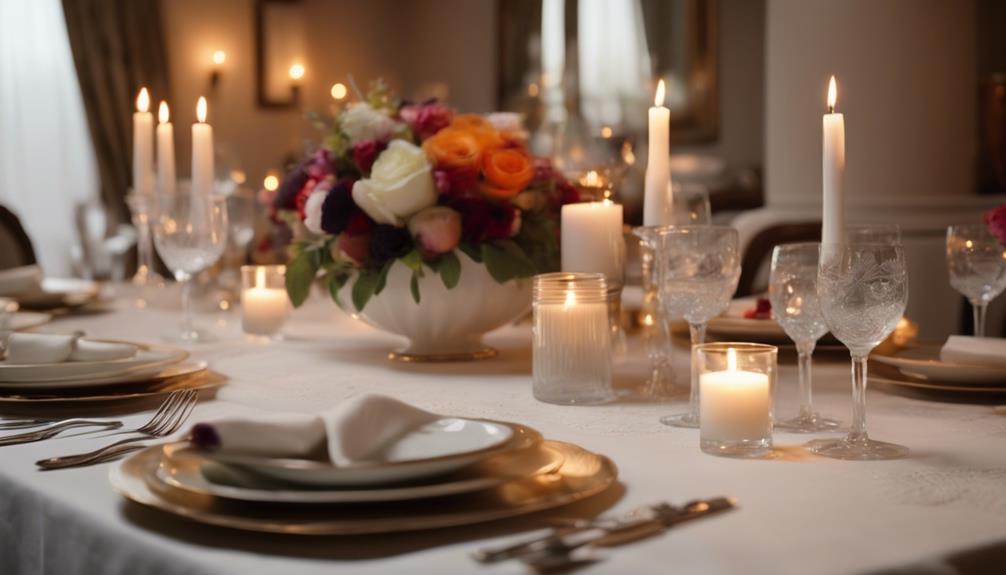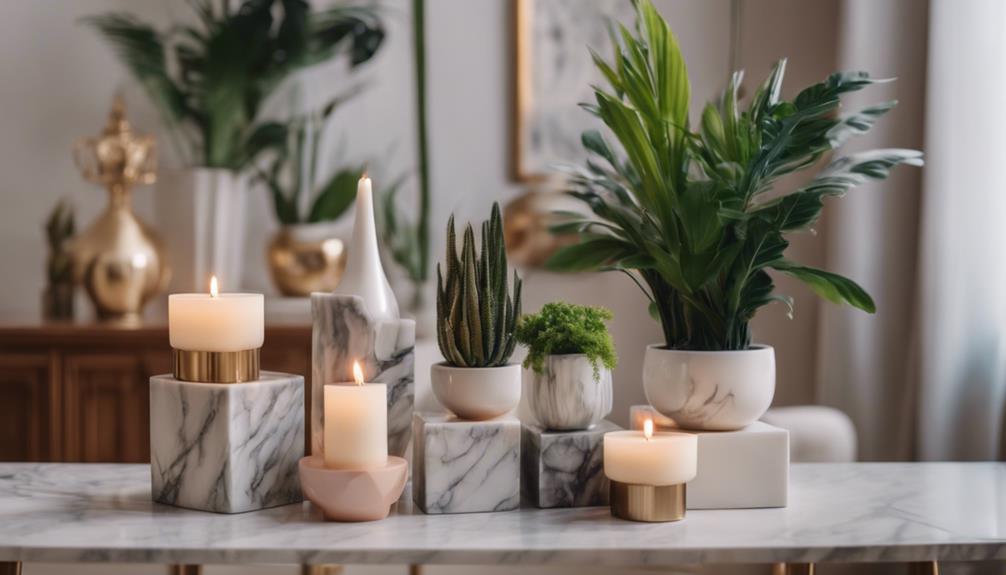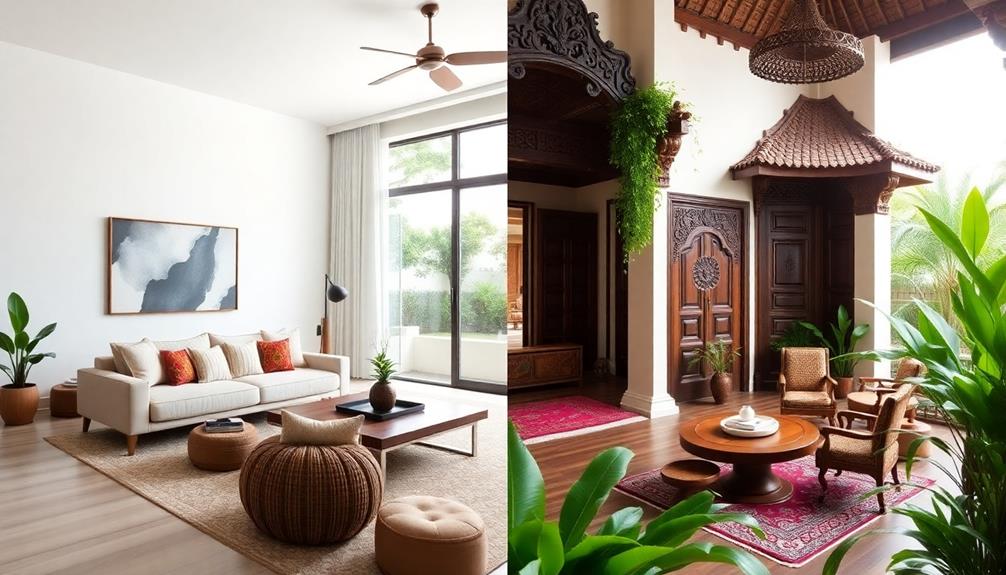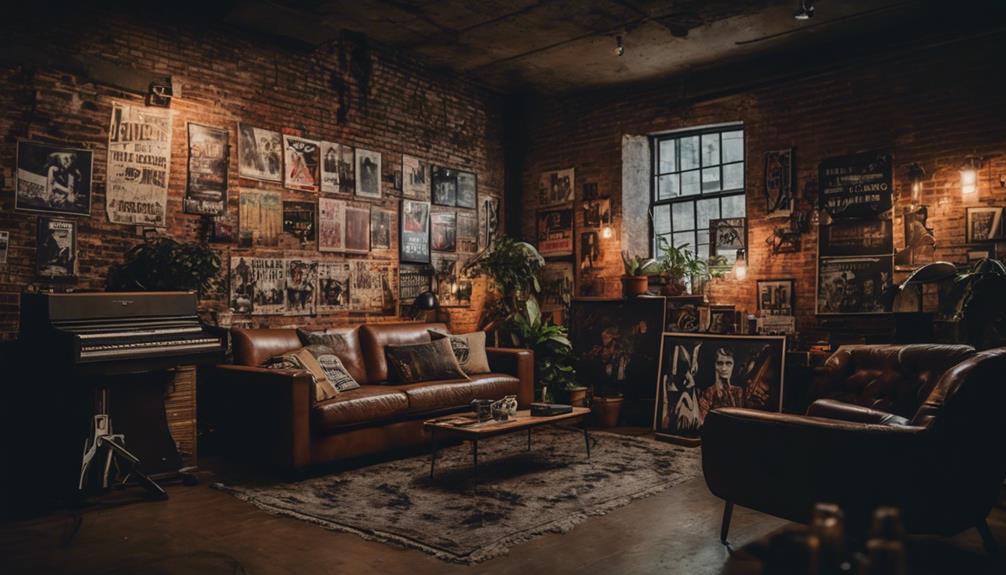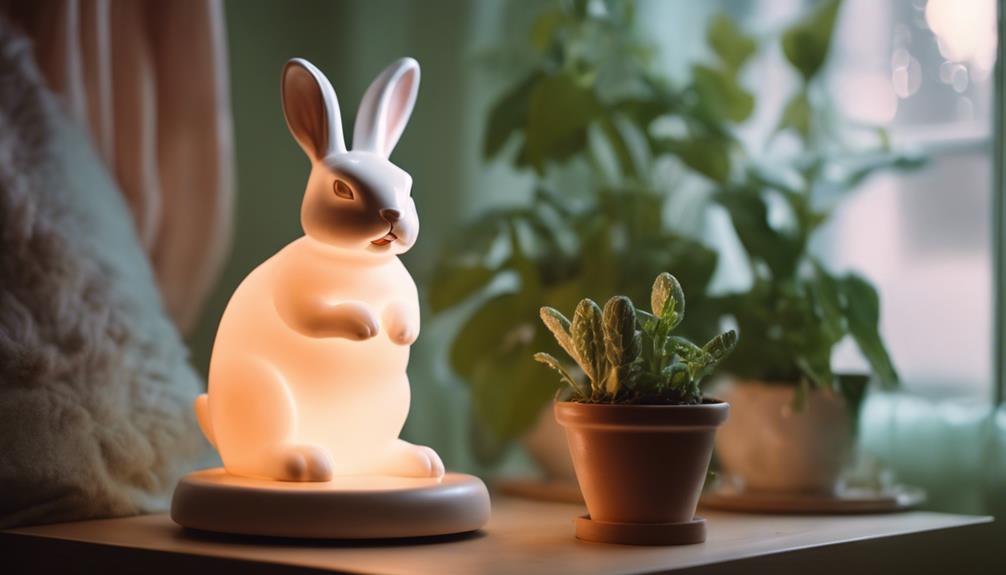To make your dinner party unforgettable, focus on tabletop decor that ignites conversation. Start with unique centerpieces, like vintage books or seasonal flowers, and mix textures to grab attention. Layering vintage linens with modern tableware adds depth and intrigue. Don't forget to incorporate personal touches, such as handwritten place cards or heirloom items, that encourage storytelling. Soft lighting creates a warm atmosphere, and colorful glassware can spark curiosity. With a thoughtful setup, your table will be a standout feature of the evening, ensuring everyone leaves talking about it long after. Keep exploring for more ideas to elevate your gatherings!
Key Takeaways
- Incorporate unique centerpieces, like vintage books or potted herbs, to spark conversation and enhance visual intrigue at the table.
- Use colorful tableware and natural elements, such as fresh flowers or seasonal produce, to create a vibrant and inviting atmosphere.
- Mix vintage and modern elements, like antique dinnerware paired with contemporary glassware, to add depth and promote discussions among guests.
- Employ interactive dining experiences, such as self-serve stations and table games, to encourage guest participation and engagement throughout the meal.
- Personalize the table settings with custom place cards and unique napkin techniques to make guests feel appreciated and enhance the overall decor.
Importance of Dinner Party Atmosphere
The atmosphere of a dinner party plays an essential role in shaping guest interactions and creating memorable experiences. A successful gathering hinges on how comfortable and engaged your guests feel, and that starts with the ambiance you create. Smaller groups of six to eight foster more intimate conversations, allowing everyone to connect on a deeper level.
Thoughtful seating arrangements and low centerpieces, like flowers or candles, enhance visibility and communication. You want to eliminate barriers that can stifle conversation, making it easier for guests to engage with one another. Unique glassware and interesting table settings can add a touch of whimsy, sparking curiosity and setting the stage for lively discussions.
Strategic lighting and decor choices further enrich the atmosphere, inviting guests to relax and enjoy the meal. A warm, inviting environment promotes a sense of community, encouraging laughter and shared stories. Additionally, family-style serving can turn your dinner into a communal experience, facilitating interaction and making it easier for guests to share and bond over the meal.
Crafting an Engaging Menu
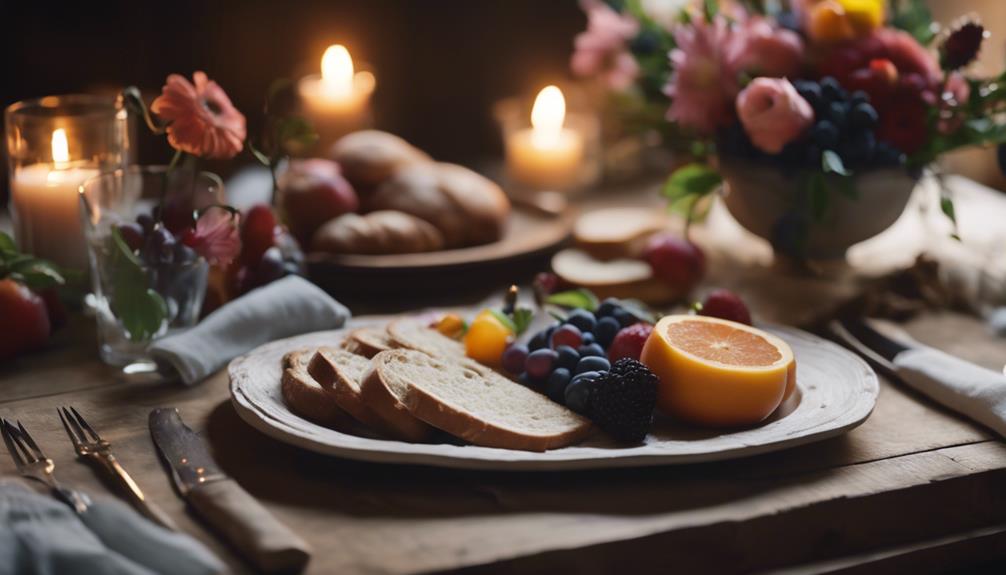
Creating an engaging menu not only complements the inviting atmosphere of your dinner party but also sparks lively conversations among guests. When you focus on crafting dinner party tables with unique food offerings, you'll encourage everyone to share their thoughts and experiences.
Consider these ideas for an unforgettable menu:
- Adventurous pairings: Incorporate unexpected ingredients that surprise and delight your guests.
- Family-style serving: This encourages interaction as guests pass dishes around, discussing flavors and preferences.
- Build-your-own dish station: Letting guests customize their meals enhances engagement and makes the experience memorable.
Creative Table Settings
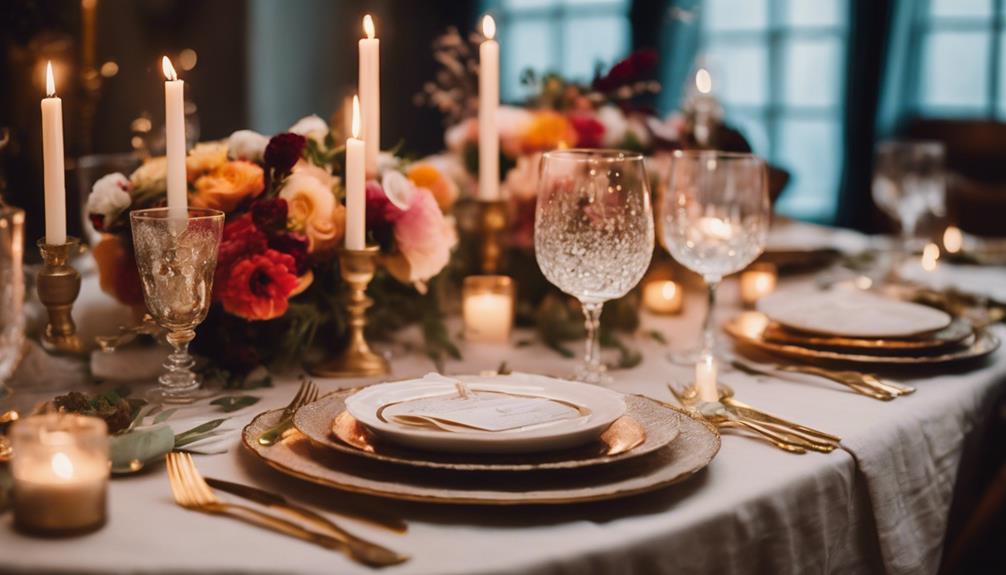
Elevating your dinner party with creative table settings transforms the dining experience into a visual feast that captivates your guests' attention. Unique place settings can greatly enhance the atmosphere, using elements like beads from local decor shops and distinctive wrapping for your silverware and napkins. This not only adds visual interest but also sparks conversation.
Incorporating natural elements like wildflowers in bud vases or fresh mint in cocktails brings charm and a personal touch to your outdoor settings. Additionally, soft lighting techniques such as string lights and candlelight can create a warm, inviting ambiance, making your guests feel right at home.
Experimenting with colorful tableware and varying textures adds depth to your creative table settings, encouraging a lively dining experience. For a sophisticated yet rustic charm, consider layering vintage linens with modern dinnerware. This blend not only enhances the aesthetic but also turns your table into a focal point that guests will love to discuss.
Interactive Dining Experiences
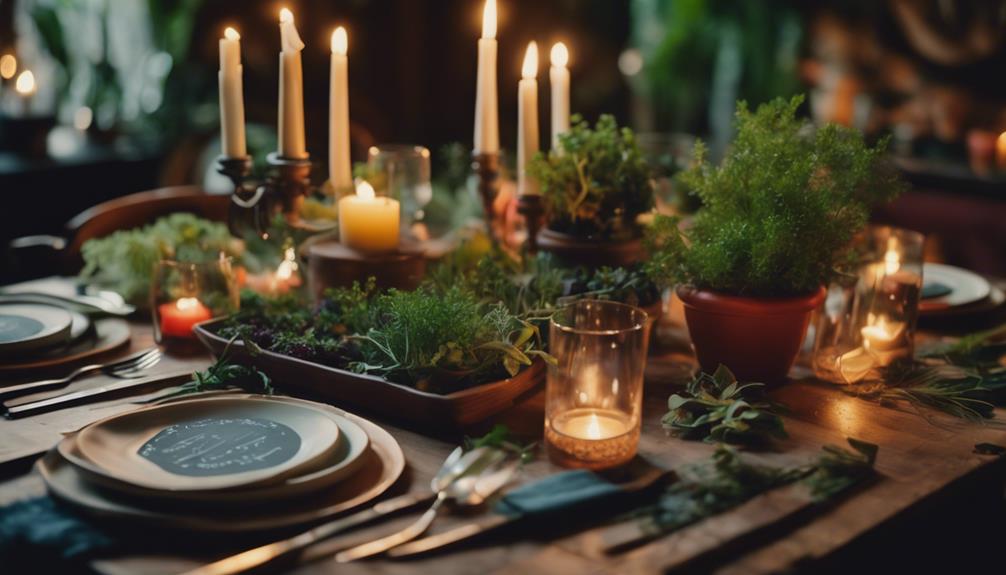
Interactive dining experiences can really enhance guest engagement, turning your dinner party into a lively event.
By incorporating technology and fun elements, you create memorable moments that your guests will talk about long after the evening ends.
Let's explore how you can use these strategies to elevate your next gathering.
Enhancing Guest Engagement
Incorporating table games and conversation starters can greatly boost guest engagement, making your dinner parties more lively and enjoyable. By integrating interactive elements into your dining experience, you encourage communication and help reduce those awkward silences that can sometimes arise at meals.
Here are a few ideas to enhance guest engagement:
- Table Games: Set up a few board games or card games that guests can play between courses. This encourages interaction and adds a fun twist to the evening.
- Conversation Starters: Place interesting questions or prompts at each setting. This sparks dialogue and allows guests to share personal stories, deepening connections.
- Self-Serve Stations: Create a self-serve drink station or communal dishes. This not only promotes participation but also fosters a relaxed atmosphere where everyone feels at ease.
Technology-Driven Interaction
Technology is transforming dining experiences by introducing interactive elements that engage guests in new and exciting ways. Imagine sitting at a table where tablets or screens facilitate games, quizzes, and conversation starters. These interactive features not only enhance engagement but also create a lively atmosphere, making meals more enjoyable and memorable.
Incorporating augmented reality into your dining setup takes it a step further. Guests can visualize food pairings or gain insights about the dishes, turning the meal into an educational experience. Plus, apps that collect data on guest preferences can personalize future dining experiences, leading to tailored menus that cater to everyone's tastes.
Interactive dining also helps eliminate those awkward silences. With digital prompts and activities available, guests can easily connect and communicate, fostering a warm, inviting environment.
The rise of smart home systems integrated with interactive dining tables offers even more convenience and engagement, allowing you to focus on your guests while technology enhances their experience.
Creating Memorable Experiences
Crafting memorable dining experiences hinges on engaging your guests through fun activities and stimulating conversation starters.
You'll want to create an atmosphere that encourages interaction and connection, making your dinner not just a meal but a platform for making special memories.
Consider incorporating the following elements to elevate your gathering:
- Games and Quizzes: Use table games or trivia related to your menu to spark laughter and friendly competition.
- Unique Food Pairings: Serve unexpected dishes that inspire conversation and allow guests to share their thoughts and experiences.
- Tech Integration: Utilize tablets or augmented reality apps to offer interactive elements, like virtual tours of your meal's origin or ingredient details.
Unique Centerpiece Ideas
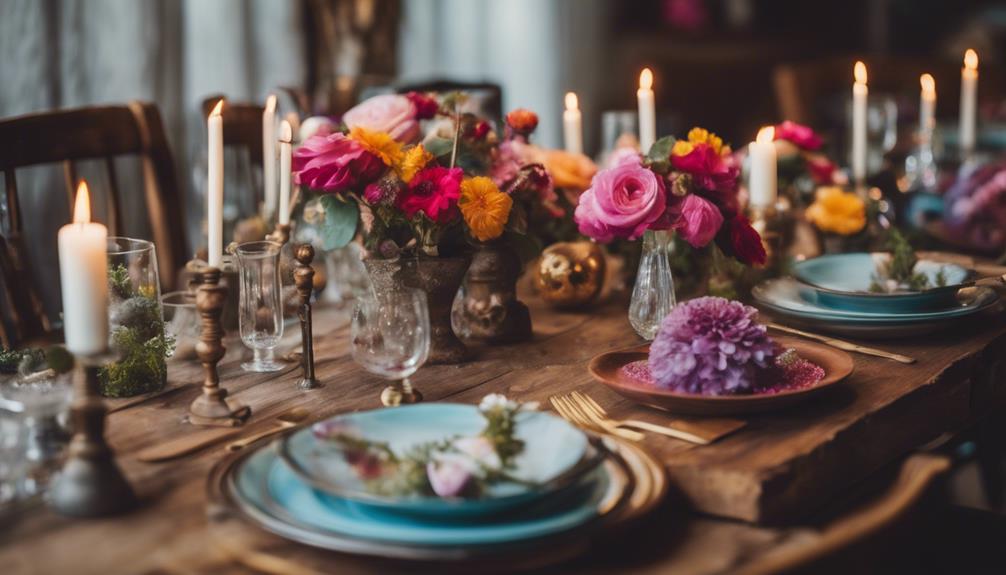
To spark conversation and add a distinctive flair to your dinner party, consider using unexpected elements like vintage books or quirky sculptures as centerpieces. These unique centerpieces not only draw attention but also serve as excellent conversation starters.
You can also incorporate natural elements like potted herbs or succulents, which enhance your table's aesthetic while providing fresh ingredients for your meal. Low-profile arrangements with seasonal flowers can be another great choice, guaranteeing unobstructed views across the table for engaging conversations.
Mixing textures and materials will elevate the overall dining experience; think glass terrariums filled with colorful stones or flickering candles that create visual intrigue.
Personalizing your centerpieces is key. Use family heirlooms or travel souvenirs to reflect your personality and the theme of the dinner party. This not only creates a memorable atmosphere but also invites guests to share their own stories, enriching the overall experience.
Embrace creativity, and don't hesitate to experiment with these unique centerpiece ideas to guarantee your dinner party is talked about long after the last bite is taken.
Seasonal Decor Inspiration
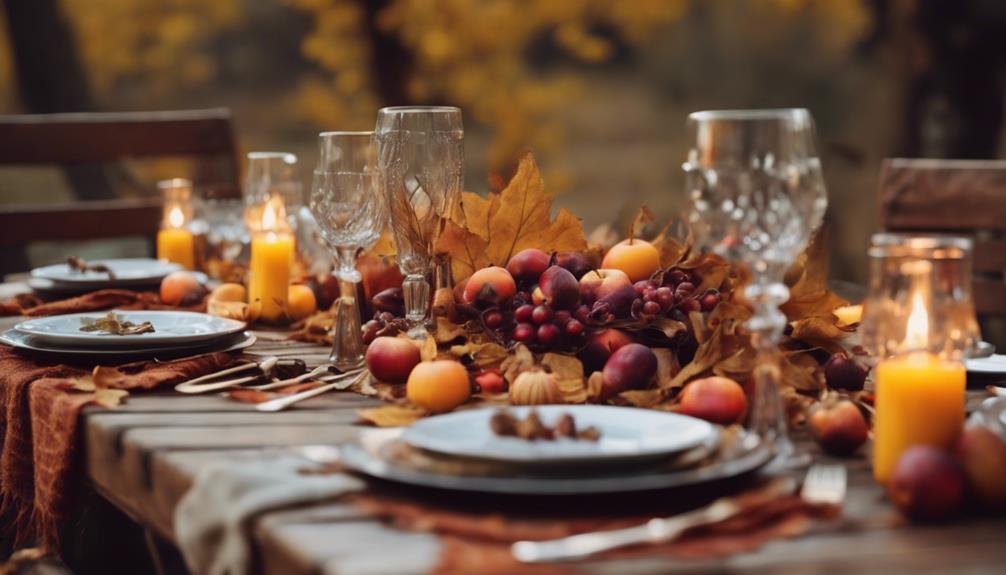
Embrace the beauty of each season by incorporating fresh flowers and vibrant produce into your tabletop decor, creating a visually stunning dining experience.
Seasonal decor can truly elevate your dining table, reflecting the colors and themes that each season brings. For spring, think pastel blooms paired with light, airy tableware. In summer, vibrant fruits and natural textures can add a revitalizing touch. As autumn approaches, rich jewel tones and leaves can warm up your gatherings, while winter calls for cozy elements like pine cones and cedar.
Here are a few ideas to inspire your seasonal decor:
- Spring: Use pastel-colored tablecloths with tulips and daffodils.
- Summer: Incorporate a centerpiece of colorful fruits like peaches and berries.
- Fall/Winter: Add warm lighting with string lights and rustic elements like pine branches.
Mixing Vintage and Modern Elements
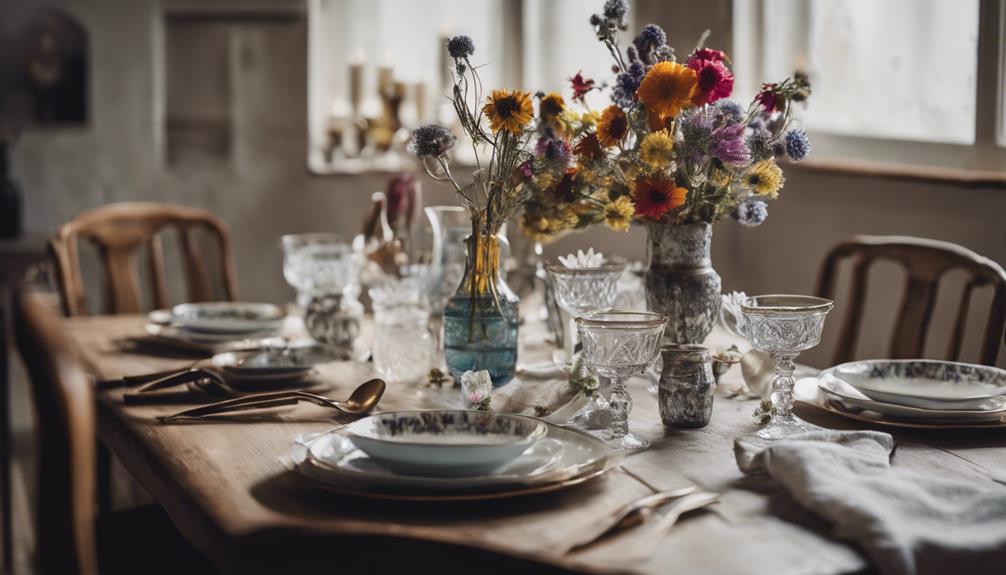
Mixing vintage and modern elements can create a timeless design that stands out at your dinner party.
You can experiment with unique textural combinations, like pairing sleek metal flatware with rustic wicker chargers.
This fusion not only enhances the visual appeal but also sparks interesting conversations among your guests.
Timeless Design Fusion
Combining vintage and modern elements in your table decor not only creates a unique aesthetic but also tells a personal story that enhances the dining experience. By thoughtfully mixing styles, you can transform your tables into a visual feast that sparks conversations among your guests.
Here are some ideas to get you started:
- Layering antique dinnerware with contemporary glassware and flatware for depth.
- Utilizing vibrant vintage linens alongside sleek, minimalist tableware for a balanced look.
- Incorporating heirloom glassware with modern serving pieces to evoke nostalgia.
When you embrace this timeless design fusion, you're not just decorating; you're curating an experience. Guests will enjoy discussing the eclectic mix of history and contemporary flair on your tables, and they'll appreciate the personal touches that reflect your taste and story.
This fusion not only enhances the visual appeal but also fosters connection among diners, making your dinner parties memorable. So, don't hesitate to experiment and let your creativity shine through as you blend the old with the new!
Unique Textural Combinations
When you layer vintage textiles with modern tableware, you create a stunning visual contrast that invites guests to appreciate the unique textures and stories behind each piece. Combining vintage dinnerware with sleek, minimalist elements like contemporary linens and glassware not only enhances the overall dining experience but also adds depth to your tablescape.
Consider incorporating heirloom glassware alongside modern flatware; this juxtaposition showcases your personal history while fostering a warm, inviting atmosphere. Vintage decor pieces, such as antique candle holders or ceramic serving dishes, can serve as statement items that draw the eye when paired with more streamlined dinner plates.
The combination of rustic vintage elements with sleek modern designs evokes a cozy yet sophisticated vibe, encouraging conversation among your guests. Layering embroidered napkins or lace tablecloths with simple, modern tableware creates a delightful balance that appeals to various tastes and promotes a sense of nostalgia.
Personal Touches for Memorable Gatherings
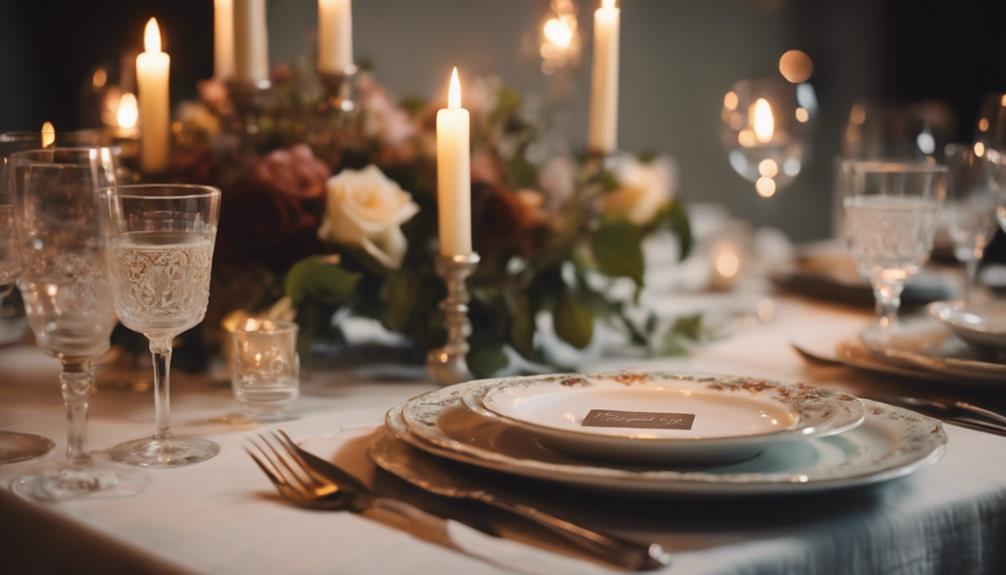
Personal touches in your dinner party decor not only create a warm atmosphere but also foster deeper connections among your guests. When you incorporate these elements, you're setting the stage for a successful dinner that leaves lasting impressions. Consider adding unique details that resonate with your friends and family.
- Heirloom Pieces: Use vintage glassware or family china to spark conversations and share stories.
- Custom Place Cards: Handwritten notes or small tokens related to each guest show you value their presence.
- Locally Sourced Flowers: Fresh blooms or herbs from your garden enhance beauty and connect to the season.
Additionally, themed centerpieces can evoke nostalgia, while unique napkin folding techniques or personalized napkin rings serve as striking visual details.
These personal touches not only beautify your table but also create an inviting environment that encourages interaction.
Future Trends in Table Decor
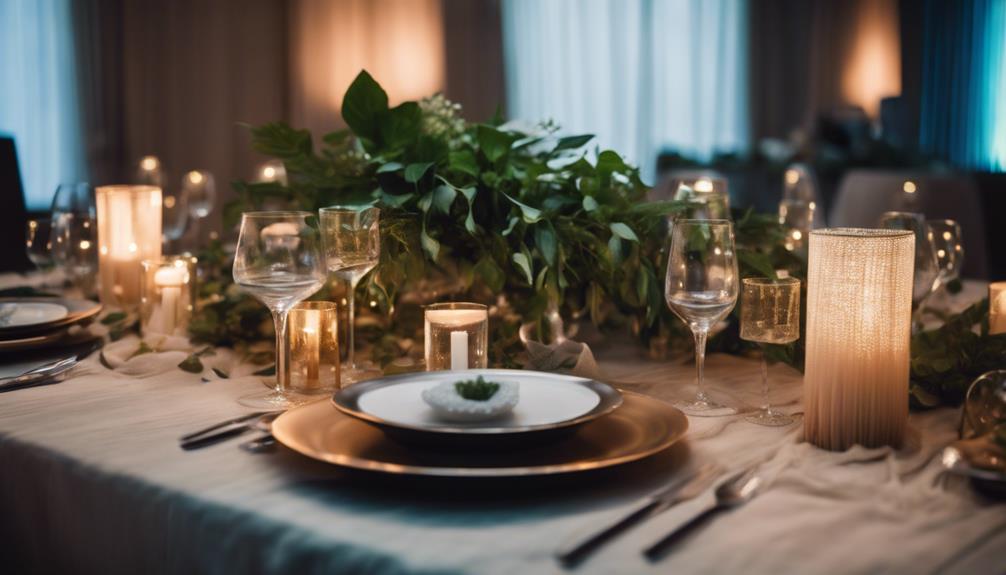
As you plan your next dinner party, keep an eye on emerging trends that are set to transform table decor into a more engaging and sustainable experience.
Imagine a table enjoying great food, adorned with eco-friendly materials sourced from recycled or responsibly sourced products. This shift toward sustainability not only reflects your values but also enhances the overall dining experience.
Interactive, AI-driven tables are on the horizon, personalizing settings to boost guest engagement. For a small dinner, these innovations can create tailored interactions that make your gathering memorable.
Additionally, embracing unique color palettes and eclectic designs allows you to mix vintage and contemporary elements, creating a visually striking table that sparks conversation.
Smart home systems will further elevate your hosting game, streamlining processes like lighting, temperature control, and music selection, so you can focus on entertaining your guests.
Finally, seasonal and nature-inspired tablescapes, featuring local blooms and produce, will continue to trend, enriching your dining experience with vibrant, contextually relevant decor.
These future trends promise to make your dinner parties unforgettable, blending style, sustainability, and innovation seamlessly.
Conclusion
In the end, your dinner party's magic lies in the details.
Picture a table adorned with flickering candlelight, vibrant blooms, and whimsical place settings that spark conversation.
By blending creativity with personal touches, you'll create an inviting atmosphere where laughter dances in the air and delicious aromas weave through the evening.
So, embrace the art of tabletop decor, and watch as your gatherings transform into unforgettable experiences that linger in the hearts and minds of your guests.
